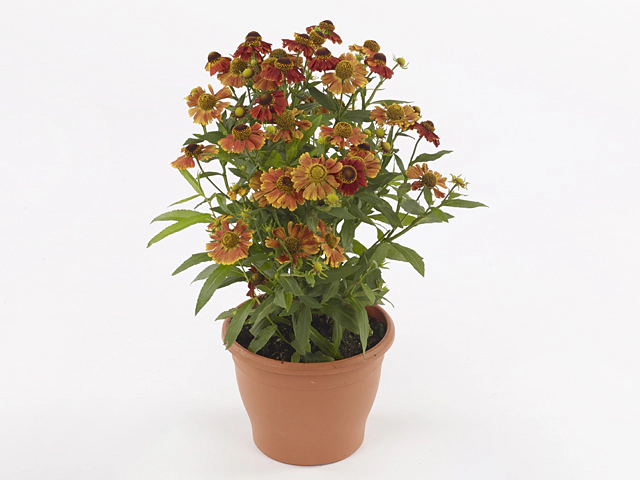Helenium Hayday Red Bicolor

| Leaf arrangement | spreaded |
| Leaf tip | Pointed/acute |
| Flower type | Single |
| Leaf margin | Serrate |
| Flower scent | Unscented |
| Winter hardness | Reasonable (USDA-zone 7) |
| Flower color | Brown-brown red-178B |
| Leaf, general shape | Lanceolate |
| Flower diameter | 4,5 - 5 cm |
| Plant height | 20 - 30 cm; 30 - 40 cm |
| Inflorescence | Capitulum (head) |
| Flowering month(s) | July; August; September |
| Leaf size | 5 - 7,5 cm |
| Leaf, main color | Dark green |
| Flower color distribution | Unicolored |
The Helenium Hayday Red Bicolor, also known as Sneezeweed, is a beautiful flowering plant that belongs to the Asteraceae family. It is a versatile plant that can be grown in a variety of conditions and is known for its unique characteristics and stunning appearance.
One of the distinguishing features of the Helenium Hayday Red Bicolor is its leaf arrangement, which is spreaded. The leaves are lanceolate in shape and have serrate margins, giving them an attractive textured look. The leaf tips are pointed or acute, adding to the overall elegance of the plant.
When it comes to the flowers, the Helenium Hayday Red Bicolor produces single flower heads called capitulum. The flower heads are notable for their brown-brown red color, classified as 178B according to the Royal Horticultural Society's color chart. The flowers are relatively large, with a diameter ranging from 4.5 to 5 cm.
One interesting aspect of the Helenium Hayday Red Bicolor is that it is unscented, which may come as a surprise to some gardeners who expect flowers to have a pleasant fragrance. Nevertheless, the eye-catching color of the flowers compensates for the lack of scent.
In terms of size, the Helenium Hayday Red Bicolor can reach a height of 20-30 cm or 30-40 cm, depending on the specific cultivar. This makes it suitable for both borders and containers, allowing gardeners to incorporate it into different planting schemes.
The Helenium Hayday Red Bicolor is known for its reasonable winter hardiness, making it suitable for USDA Zone 7 and similar climates. This means that it can withstand relatively cold temperatures and survive through the winter months without extensive protection.
This particular Sneezeweed cultivar blooms during the months of July, August, and September, adding a touch of color to the late summer garden. The inflorescence is composed of numerous flower heads that create a visual spectacle when in full bloom.
Overall, the Helenium Hayday Red Bicolor is a fascinating plant with its unique leaf arrangement, striking flower colors, and reasonable winter hardiness. Whether used as a border, container plant, or in mixed perennial beds, it is sure to attract attention and enhance the beauty of any garden.